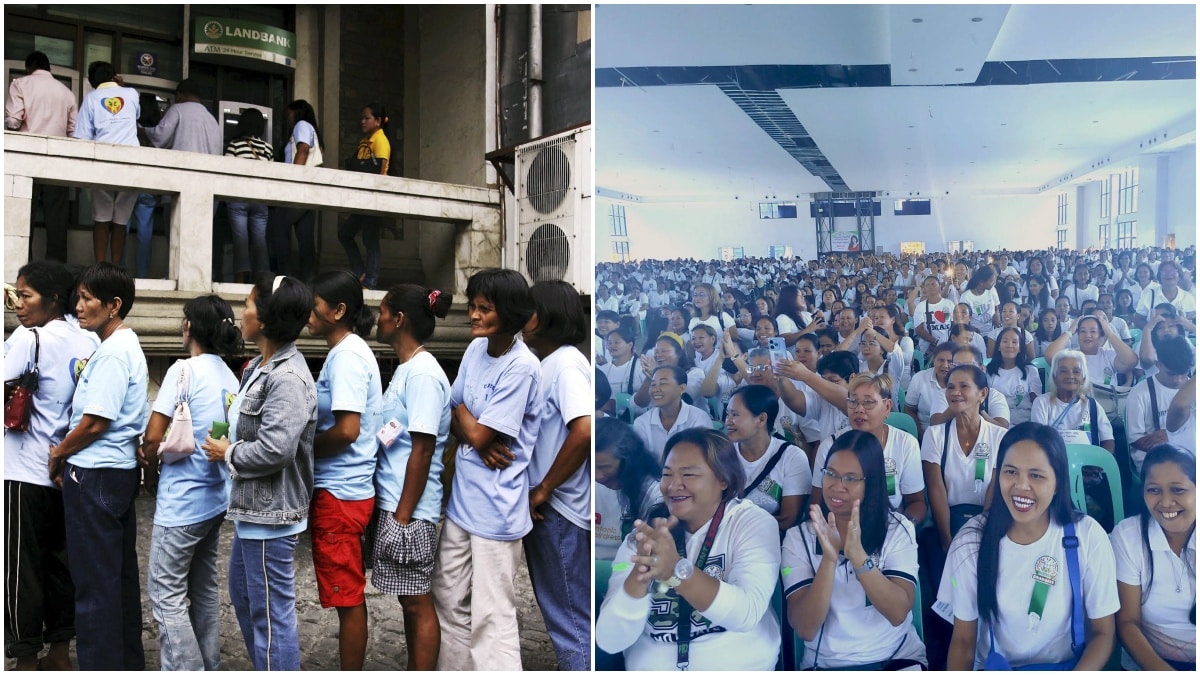DSWD eyes adding 1.2M poor households to 4Ps

“PANTAWID’ THROUGH THE YEARS 4Ps beneficiaries in 2011 (left) , three years into the government’s flagship poverty program, line up at an ATM in Lucena City to withdraw money from their allotments; (right) some 2,000 beneficiaries in Pandi, Bulacan, are graduated from the program in June this year. —Inquirer photo/Pantawid Pamilyang Pilipino Program Facebook page
MANILA, Philippines — The Department of Social Welfare and Development (DSWD) is considering soon including a total of 1,184,768 households in the Pantawid Pamilyang Pilipino Program (4Ps), the agency said on Sunday.
DSWD spokesperson Irene Dumlao said that more than 400,000 households had already qualified for the conditional cash transfer scheme, the government’s flagship antipoverty program.
According to Dumlao, the 424,317 households were next in line to replace the beneficiaries who recently exited the program in the recent “Pugay Tagumpay” ceremony.
READ: DSWD: 4Ps not a dole-out program
“All of them were validated based on the needed number to be replaced,” Dumlao told the Inquirer in a Viber message.

Poverty threshold
“This is one of the highest numbers that we have validated so far because of the high number of beneficiaries that exited due to improved level of well-being and natural attrition,” she added.
According to the program’s criteria, a household must be at or below the poverty threshold of its province to be eligible.
Dumlao said the DSWD was using the proxy means test, a statistical model that estimates the income of poor families according to variables such as family composition, education of family members, and access to basic services. Urban and rural poor incomes are estimated separately, she said.
The Philippine Statistics Authority (PSA) reported that in 2023, the poverty threshold was highest at P16,046 a month in Central Luzon, P15,713 in Metro Manila, and P15,457 in Calabarzon (Cavite, Laguna, Batangas, Rizal, and Quezon). The lowest was P12,241 in Soccsksargen (South Cotabato, Cotabato, Sultan Kudarat, Sarangani, and General Santos City).
Among the other conditions a household must meet is that it must have a family member who is zero to 18 years old and/or a pregnant member at the time of registration.
If validated, this particular household will replace by next year the beneficiary family that had graduated from the program, according to Dumlao.
Reassessment
Under the 4Ps, each household receives P750 monthly for health needs, P300 per child who is in the elementary grades, P500 per child in junior high school, and P700 per child in senior high school.
A maximum of three children per household can qualify for the monthly payout for 10 months in a school year.
A household that is compliant with the requirements will also receive a monthly rice subsidy of P600.
In July last year, Social Welfare Secretary Rex Gatchalian ordered a reassessment of all 4Ps beneficiaries who were tagged as “nonpoor” under the Listahanan 3.
Gatchalian’s order resulted in the reinstatement of more than 700,000 beneficiaries who were removed from the list.
Launched in 2008 and institutionalized by Republic Act No. 11310 in 2019, the 4Ps is the national poverty reduction strategy and human capital investment program of the government.
It provides cash aid to poor households for a maximum of seven years to improve children’s health, nutrition, and education.
In February, the DSWD said that more than 700,000 of the 4.4 million 4Ps beneficiaries had graduated from the program.
Of this number, Gatchalian said 65 percent, or 482,000, were due to self-sufficiency while 34 percent, or 248,000, graduated because of natural attrition.
Apart from reaching the seven-year limit, or the “self-sufficient” level, there are several other ways that beneficiaries may exit or be removed from the program.
Expected to graduate
One is when the last child being monitored in the household reaches 18 years old, or has completed high school. Another is the voluntary withdrawal from the program. Program violations or offenses would result in either penalties or removal from the program.
According to the 2024 First Quarter Report of the DSWD, the 4Ps program has already served 6.4 million poor households nationwide since it began.
As of the end of March, the program was still serving 4.4 million active household beneficiaries in 41,746 barangays in all 148 cities and 1,485 municipalities across 82 provinces nationwide.
In October, the DSWD said it was expecting some 500,000 household beneficiaries of the 4Ps to graduate from the program by the end of 2024.
Households that have already graduated from the 4Ps are endorsed to their local governments for other assistance, such as the sustainable livelihood program.
Dumlao said the current target number of household beneficiaries was 4.4 million. The number of households whose level of well-being had improved from “survival to subsistence to self-sufficiency” would be replaced to stay on target. —with a report from Inquirer Research